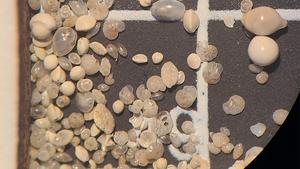image:
Benthic foraminifera from one of the oxygen-rich sections found in our study. Photo: MARUM – Center for Marine Environmental Sciences, University of Bremen; S. Barragán-Montilla
view more
Credit: MARUM – Center for Marine Environmental Sciences, University of Bremen; S. Barragán-Montilla
Salt water in the oceans is not the same everywhere; There are water layers that have different salinities and temperatures. The phenomenon of thermohaline circulation – which results from the differences in density caused by variations in temperature and salinity – drives the Atlantic Meridional Overturning Circulation (AMOC), among other current patterns. Near the surface, however, ocean circulation is also influenced by winds, which are responsible for producing the large subtropical gyres in the Atlantic, both on the northern and southern sides of the equator. These gyres play an important role for marine ecosystems because they provide organisms on the sea floor with oxygen, which is then consumed in part by the decomposition of organic matter. If there is a paucity of fresh, cold, and oxygen-rich water transported in to ventilate these areas, so to speak, oxygen minimum zones result.
A team of researchers from MARUM – Center for Marine Environmental Sciences and the Department of Geosciences, both of the University of Bremen, from the Kiel University, and from the Lyell Centre at Heriot-Watt University in Scotland have now investigated how the weakening of Atlantic Meridional Overturning Circulation is connected to the ventilation of the shallow ocean. Their focus was on the tropical oxygen-minimum zone off northwestern Africa.
In their study, based on benthic foraminifera – microscopically small single-celled organisms that produce a shell and live on the ocean floor – the team was able to reconstruct changes in the oxygen content of the oxygen-minimum zone in the eastern tropical North Atlantic over the past 27,000 years. “Benthic foraminifera react to changes in oxygen, which affects their distribution, among other things. Employing these small microscopic fossils, we studied how the oxygen content of the ocean changed at a time when the AMOC, according to research, was weaker than it is today. This provided us with insights to the effects of the AMOC strength on the shallow-water cells,” explains Dr. Sofía Barragán-Montilla. She earned her PhD at MARUM and is now a research scientist in the Paleocenography working group at the Institute of Geosciences at Kiel University.
The question of whether and how the AMOC will slow down in the future continues to be discussed in scientific circles. The team of scientists has taken the basic question a step further: What happens to the shallow cells if the AMOC circulation weakens? “We were surprised to discover how closely the oxygen content off northwest Africa is linked to the state of the Atlantic Meridional Overturning Circulation,” explains Dr. Stefan Mulitza of MARUM. In the deep Atlantic, a weakening of the meridional circulation leads to a decrease in oxygen content. The shallow layers of the Atlantic, on the other hand, are better ventilated with a decline in the AMOC. This is a result of stronger winds driving the subtropical gyre, which are intensified by greater temperature and air-pressure differences between the tropics and higher northern latitudes.
The first author, Dr. Sofía Barragán-Montilla studied the benthic foraminifera that led the team to the findings of their study. “We discovered that in times of a weaker AMOC more oxygen was present in the oxygen-minimum zone of the eastern tropical North Atlantic, which indicated a strengthened shallow cell.”
An additional finding of the researchers was that the intensity of the oxygen-minimum zone off northwest Africa is significantly controlled by ocean circulation and depends less on variations in oxygen depletion due to the decomposition of organic material.
The findings of the current study will continue to be investigated within the Cluster of Excellence “The Ocean Floor – Earth’s Uncharted Interface”, which is housed at MARUM. One research topic of the cluster is how complex ecosystems react under changing environmental conditions.
Participating institutes:
- MARUM – Center for Marine Environmental Sciences, University of Bremen
- Kiel University (CAU), https://www.paleoceanography.ifg.uni-kiel.de
- Geosciences Department, University of Bremen
- Lyell Centre, Heriot-Watt University, Edinburgh, Great Britain
- Millennium Nucleus UPWELL, Concepcion, Chile
MARUM produces fundamental scientific knowledge about the role of the ocean and the seafloor in the total Earth system. The dynamics of the oceans and the seabed significantly impact the entire Earth system through the interaction of geological, physical, biological and chemical processes. These influence both the climate and the global carbon cycle, resulting in the creation of unique biological systems. MARUM is committed to fundamental and unbiased research in the interests of society, the marine environment, and in accordance with the sustainability goals of the United Nations. It publishes its quality-assured scientific data to make it publicly available. MARUM informs the public about new discoveries in the marine environment and provides practical knowledge through its dialogue with society. MARUM cooperation with companies and industrial partners is carried out in accordance with its goal of protecting the marine environment.
Journal
Nature Communications
Article Title
Enhanced ventilation of Eastern North Atlantic Oxygen Minimum Zone with deglacial slowdown of Meridional Overturning
Article Publication Date
15-Jul-2025
Disclaimer: AAAS and EurekAlert! are not responsible for the accuracy of news releases posted to EurekAlert! by contributing institutions or for the use of any information through the EurekAlert system.
